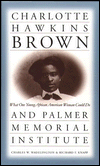

 |

|

Sold Out
Book Categories |
CONTENTS Preface Introduction
1 From North Carolina to New England and Back
2 Bethany Institute Becomes Palmer Memorial Institute
3 Brown's Hopes and Dreams
4 A New Respectability
5 From Tragedy to Triumph, 1918-1922
6 The New Palmer, 1922-1927
7 The AMA Years, 1927-1934
8 Independence and Stability, 1934-1952
9 In Brown's Shadow, 1952-1971
Epilogue Appendix 1: Chronology Appendix 2: Selected Newspaper Articles on Charlotte Hawkins Brown and Palmer Memorial Institute Notes Bibliography Index
Illustrations
Charlotte Hawkins Brown, 1952
Artist's depiction of Brown arriving in Guilford County, 1901
Charles B. Aycock James Y. Joyner Brown, circa 1905
John D. Hawkins Jane A. Hawkins, circa 1887
Artist's depiction of African Americans waiting to leave North Carolina, 1890
Caroline Hawkins Willis, 1924
Ray Greene Huling, circa 1893
Alice Freeman Palmer Manuel L. Baldwin Palmer's first classroom and dormitory building, circa 1917
Bethany Congregational Church, circa 1903
Charles D. McIver, circa 1900
Memorial Hall, 1917
Brown and faculty, 1907
Palmer family, circa 1907
Grinnell Cottage, circa 1917
Palmer's campus, circa 1915
Brown in her wedding gown, 1911
Dairy barn on Palmer's farm, 1917
Brown and colleague, circa 1911
Galen L. Stone, circa 1920
Class of 1916
Brown examining produce from the school farm, circa 1916
Students in dining hall, circa 1916
Palmer baseball team, circa 1916
Carrie M. Stone Alice Freeman Palmer Building, circa 1922
Brown in faculty room, circa 1930
Students in library, circa 1930
Wellesley Auditorium, circa 1930
Agricultural and vocational classroom, circa 1930
Domestic science class in cooking, circa 1930
Brown in front of Canary Cottage, circa 1935
Social function at Canary Cottage, circa 1940s Galen Stone Hall, circa 1950
Kimball Hall, 1997
"Three Bs of education," circa 1940s Sedalia Singers, circa 1940s Students dancing a minuet, circa 1930s Students costumed for a drama, circa 1940
Palmer's baseball team, circa 1930s Charles W. Eliot Hall, 1947
Reverend John Brice, 1947
Brown and children in Canary Cottage, 1947
Dance group in Wellesley Auditorium, 1947
Orchestra practice, 1947
Brown with senior, 1947
Posture and poise practice, 1947
Dormitory life in Stone Hall, 1947
Brown lecturing in Wellesley Auditorium, 1947
Palmer's "triangle of achievement," 1943
Students pausing for prayer in Kimball Hall, 1947
Students at Tea House, 1947
At the prom, 1947
Students shopping in Greensboro, 1947
Brown and Wilhelmina Crosson, 1952
Brown and Crosson in receiving line on lawn of Canary Cottage, circa 1952
Brown celebrating birthday in Canary Cottage, circa 1953
Richard L. Wharton Maria Hawkins Cole, H. M. Michaux Jr., L. Annette Gibbs, and Marie Hill Gibbs, circa 1985
William Martin, 1997
Dedication of Charlotte Hawkins Brown Memorial, November 7, 1987
Login|Complaints|Blog|Games|Digital Media|Souls|Obituary|Contact Us|FAQ
CAN'T FIND WHAT YOU'RE LOOKING FOR? CLICK HERE!!! X
 You must be logged in to add to WishlistX
 This item is in your Wish ListX
 This item is in your CollectionCharlotte Hawkins Brown and Palmer Memorial Institute: What One Young African American Woman Could Do
X
 This Item is in Your InventoryCharlotte Hawkins Brown and Palmer Memorial Institute: What One Young African American Woman Could Do
X
 You must be logged in to review the productsX
 X
 X

Add Charlotte Hawkins Brown and Palmer Memorial Institute: What One Young African American Woman Could Do, In the fall of 1901, Charlotte Hawkins Brown (1883-1961) jumped off a Southern Railway train in the unfamiliar backwoods of Guilford County, North Carolina. She was black, single, and barely eighteen years old and had come alone from Cambridge, Massachuse, Charlotte Hawkins Brown and Palmer Memorial Institute: What One Young African American Woman Could Do to the inventory that you are selling on WonderClubX
 X

Add Charlotte Hawkins Brown and Palmer Memorial Institute: What One Young African American Woman Could Do, In the fall of 1901, Charlotte Hawkins Brown (1883-1961) jumped off a Southern Railway train in the unfamiliar backwoods of Guilford County, North Carolina. She was black, single, and barely eighteen years old and had come alone from Cambridge, Massachuse, Charlotte Hawkins Brown and Palmer Memorial Institute: What One Young African American Woman Could Do to your collection on WonderClub |